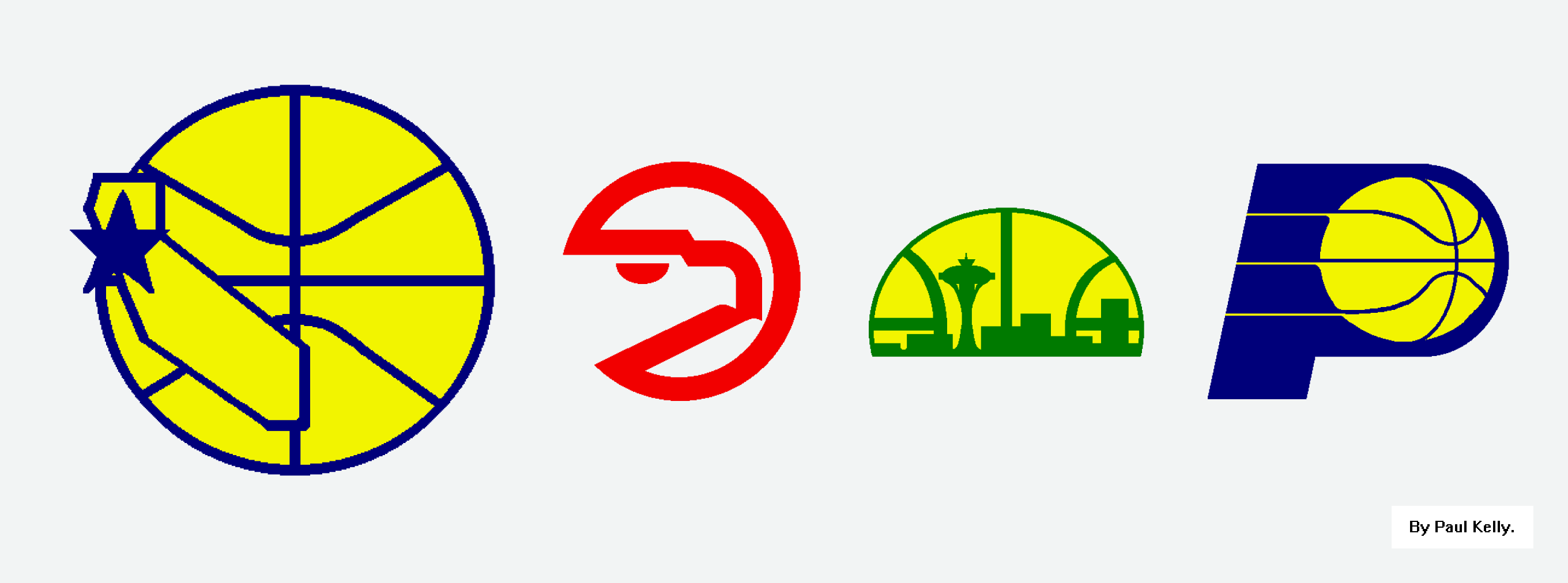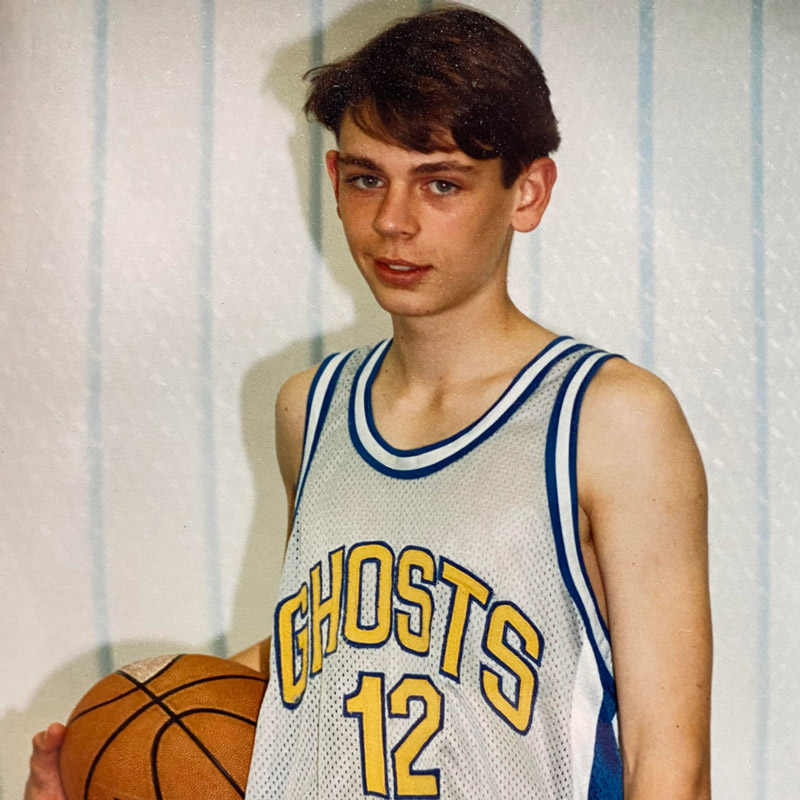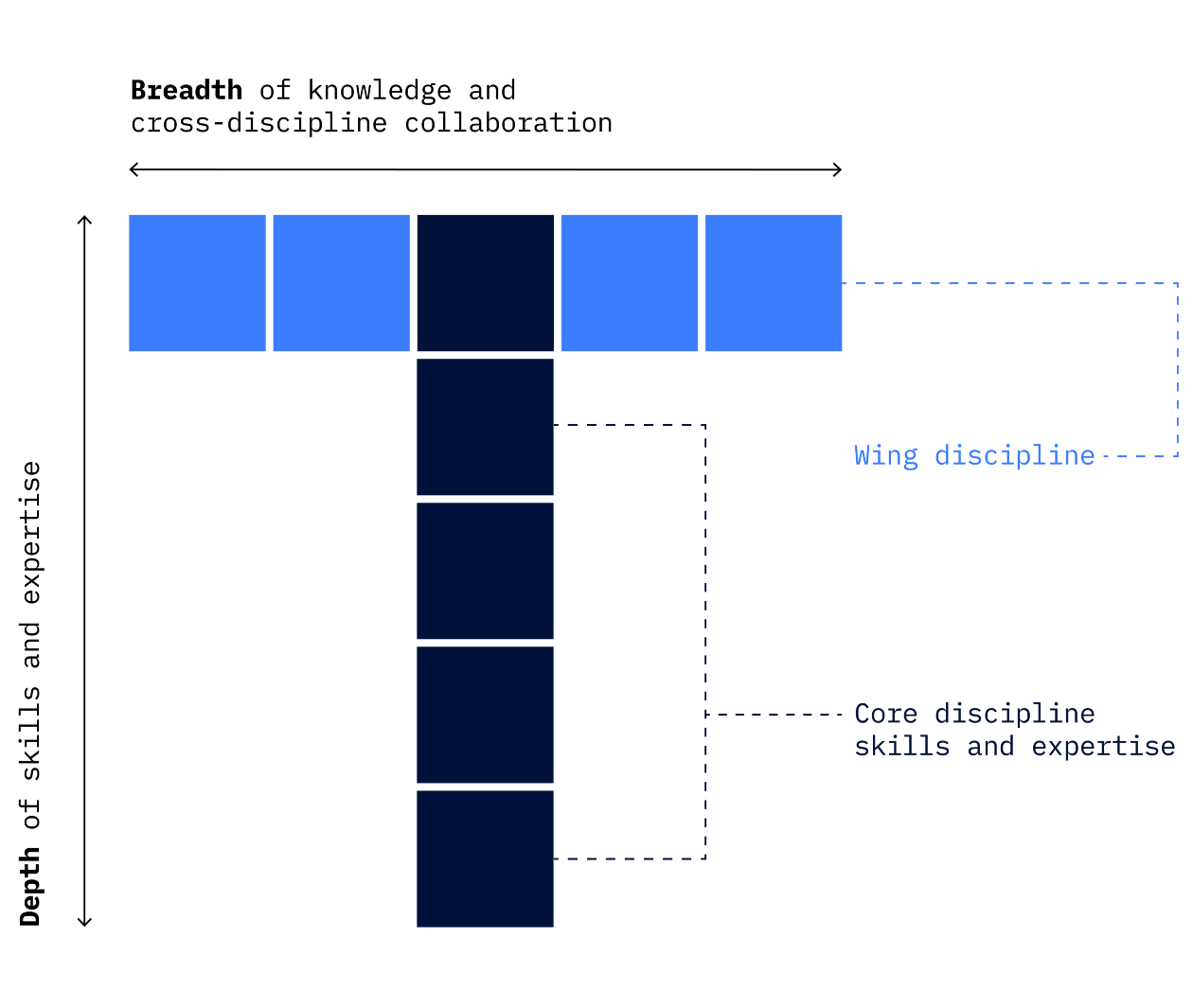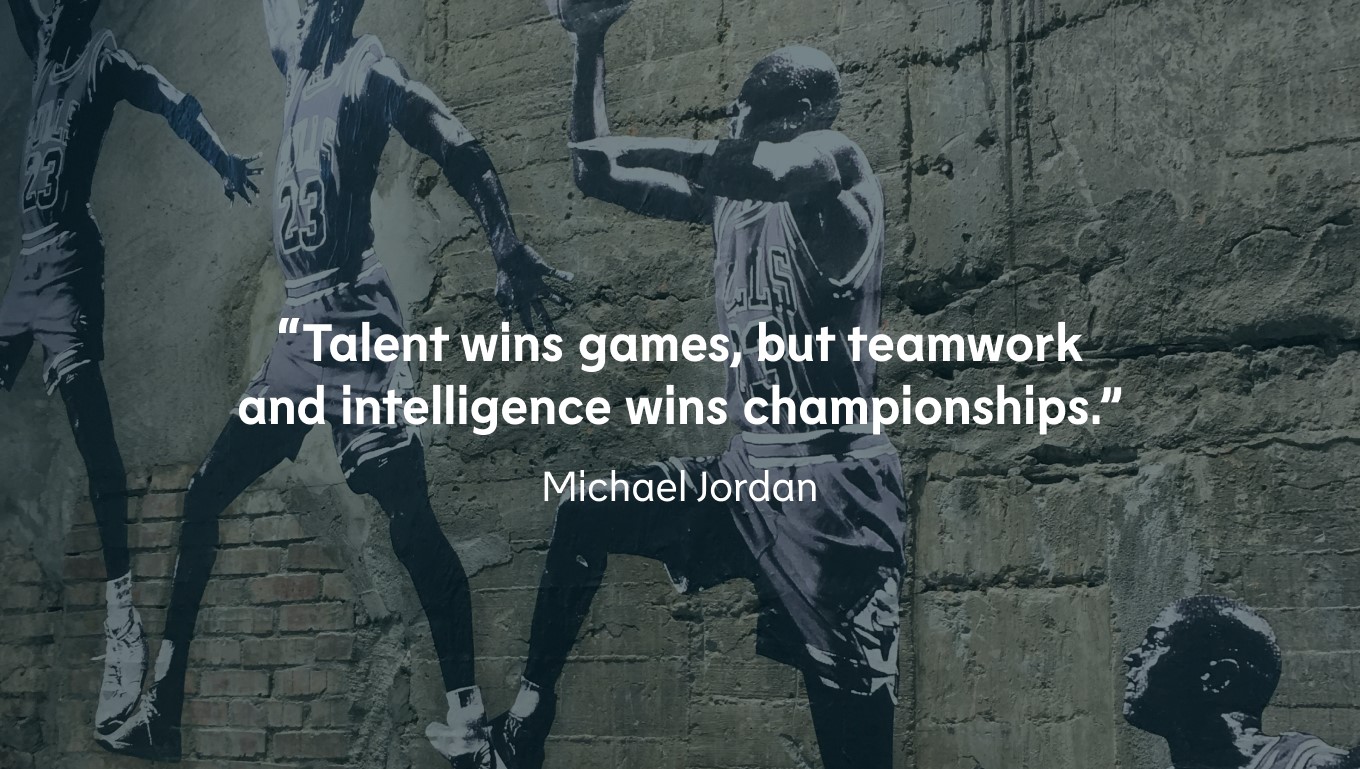Allow me to start by taking you back to a golden era... A time when Yahoo was Serious, tie dye was rad, Will Smith was Fresh and Reeboks were pumped. It was the early 90s, I was an impressionable teenager and I was obsessed with the game of basketball.
Michael Jordan had just emerged as a global sporting icon, and he and his famed Chicago Bulls were on their way to winning their first three-peat of the decade. Swept up in MJ-mania, I was enthralled by the drama of series-winning baskets and the spectacle of sport superstars. Some of my earliest attempts at digital design were attempts to recreate iconic NBA team logos pixel-by-pixel with MS Paint.

At this early age, I saw the sport in its simplest form — put the ball through the hoop more than the other team. Pretty simple right?
I wore through VHS tapes watching highlight reels over and over that I’d recorded off the TV. I’m sure I must have driven my neighbours crazy, constantly dribbling a basketball as I tried to mimic the moves of some of the great players of that era. From Tim Hardaway’s Killer Crossover, to the passing and spin moves of Magic Johnson and Jordan’s fadeaways, I would work on my individual game in my backyard from early morning to after dark with dreams of one day playing on the big stage.
At the time, I had little appreciation or concept of the complexity of basketball as a team sport. Systems of offence or defence, juggling team salary caps and player trade values were foreign concepts to me.
From shooting about in my backyard, playing in social comps with mates, joining my High School team and having parents who were patient enough to drive me all over Sydney to compete at a 2nd grade state level, I enjoyed playing immensely. And with a decent jump shot, an appetite for defence and slightly above average height, I was reasonably good at it.

But then something happened...
On reflection it was likely a combination of Jordan retiring, the emergence of grunge culture that told my teen spirit trying just wasn’t cool, plus a desire to hang out with mates outside of the basketball court… somewhere along the way my passion for basketball just faded away like one of Jordan’s turn around jump shots.
Before I knew it, I had swapped my basketball kicks for Doc Martin boots.
Instead of Friday nights at the basketball court, I was sweating it out in mosh pits at all-ages gigs. MS Paint files of NBA logos were discarded as I instead tried to recreate band name logos of that era. And rather than watching VHS tapes of hoops highlights, I took an interest in photography and the grunge aesthetic in music videos, album covers and poster art.
I hadn’t realised it at the time, but a new passion had taken hold — graphic design was my new jam.
With an ever-present appreciation for visual art, the newly-discovered grunge aesthetic as a rejection of the rules of traditional graphic design appealed to me, as a tangible gateway to ‘cool’.
Just in time too, as I gravitated without hesitation, towards a graphic design degree as a pathway through university.

Creating graphic design digitally in the late 90s and early days of internet adoption, the appeal and opportunity for User Interface Design (as juvenile as it was then) quickly found its way into my work.
A number of years later, as I explored strategic design principles and activities that delivered value for users beyond aesthetic alone, the term UX started to turn up as a way to describe the work I was doing.
While I would keep an eye on some of the major news from the NBA or get in the odd shoot around at a local court, for around the next twenty years and the majority of my design career, my interest in basketball remained on the backburner.
It wasn’t until my late thirties that my appreciation for the game resurfaced.
As 40 rapidly approached, I found myself dabbling in basketball highlight reels on YouTube and kicked off chats with mates who still followed it closely. The concept that I could access the sport again as an adult felt like an indulgent treat—like eating coco pops as a grown up.
It was hard to ignore the ripples Steph Curry and an up-and-coming Golden State Warriors team were making at the time. As my default go-to team on NBA Jam two decades earlier, I took notice.
In January 2015 I watched Steph’s ‘Splash Brother’ teammate, Klay Thompson, score a record breaking 37 points in a quarter, huddled around a best mate's phone over a few beers.
Klay had gone into video game mode. He was on fire. We were high fiving and I was hooked. My passion for the sport was reignited. I locked in on following the Warriors again and I went all-in on the NBA once more.
Now, instead of taping highlights from the TV to VHS once a week, a little thing called the internet meant I could watch games directly, live from my phone.
I could rewatch famous highlights whenever I wanted on YouTube or instead of schlepping to a newsagent to flick through pictures and stats of players in magazines, I could get up-to-date with all the latest news via access to an arena of podcasts, sport news sites and social content.
Now as an adult, and someone who had made a living working and leading teams that solve complex problems in tech-driven product design, I found myself with a new layer of appreciation.
My ability to recognise strategy and aspects of the complexity of the game had grown. All of a sudden, I could more easily see the strategic thinking that went into a game and a season.
With time away from the game and exposure to critical thinking, strategic planning and an appetite for nuance, I looked for deeper insight into the way teams are structured, to adjust tactics and squads depending on who they needed to play to get all the way to the top and win an NBA championship.
Basketball and business
Nowadays, as I finish a basketball podcast, feeding my hoops geekdom with analysis of what it is that makes great teams or players successful, and I jump into a book about leadership cultures at Google, Pixar or Apple, I find myself seeing parallels between winning team cultures across basketball and business.
The basketball court is a lot like a digital agency — fast-paced, high-energy and a collaborative space with multiple challenges to juggle at once.
My passion for basketball, playing the game as part of a team and following analysis of the way successful NBA teams are managed and coached, has now overlapped with my experience working within the digital industry leading a team of specialist UX Researchers and Experience Designers.
Experience Design is a team sport
Experience Design is at its core, a team sport.
Just as on the court each team player has a specific role to play, successful human-centred design is a cross-functional responsibility, not only within the discipline of design, but beyond the design department.
We rely on all other departments to effectively collaborate to score project team goals and deliver experiences that don’t end with design team ability alone.
Excellence in individual talent can only take a team so far in both basketball and business and no matter how good one player is, they’re never as good as the collective efforts of a collaborative team that can recognise how best to share responsibilities.
As the G.O.A.T. says himself, “Talent wins games, but teamwork and intelligence wins championships.” – Michael Jordan.
I had to learn to be selfless on the court. Working with others as a team towards a common goal, ego often had to be put aside. Recognising the role of others in achieving success together came before individual wants.
Commitment and personal sacrifice for a group, comes with the reciprocal benefit of connection between teammates — an absolute highlight of work and play.
I would come to find that leading a team requires an ability to balance individual ambition while continuing to win as a team. This is a constant and exciting challenge in keeping people engaged while continuing to win together.
Now when that clicks into place, it’s the ultimate score.
Positionless UX teams
While each player has their specific role in a team, they’re ideally not constrained by that role.
Positionless basketball has been one of the more successful trends in the NBA over the last few years.
Traditionally, players would fit into one of five distinct positions on a basketball court — Centre, Power Forward, Small Forward, Shooting Guard and Point Guard — with each position having a specialist role.
In recent years, the limits in this traditional way of how players should be considered, has been challenged.
The team I follow, the Golden State Warriors has been dominant over long periods in recent years, in part due to their ability to realise a system of play based on efficiency, versatility and winning as a team through a positionless basketball system.
Everyone has a role, everyone contributes to move the ball quickly, set up mismatches and get the open look to score.

Now positions matter less than the combined skills players can bring to the court.
Almost no player has every skill, it’s instead best to consider the team as a system and maximise the skills of each person to cover all the necessary requirements to tip the advantage your way whenever needed.
Just like any good NBA team, a User Experience team needs a mix of skills and experience to be successful. Researchers who can understand user needs, strategists who can see the big picture and connect the dots between business goals and customer needs, designers who can create beautiful interfaces — everyone is important.
All these different pieces need to come together to create a cohesive unit that can take on anything that comes their way, and having the ability to cross into other UX specialisms within the team system allows this to happen more easily.
While recognising individual specialism is important, limitations caused by an attachment to the boundaries of UX titles and roles can be resolved when we stop thinking in terms of positions, and instead think in terms of available skills within a wider system.

At Mudbath, each of the members in the Experience Design department self-evaluate themselves on 27 different skills within the broad field of Experience Design. This 'Skills Matrix' allows individuals to honestly appraise where they currently see their own strengths while also highlighting opportunities to grow and develop in the future.
This provides clear goals and areas of focus on skills at an individual level. And by combining the teams’ matrix maps, a single view of department skills and how they all fit together as a system, becomes more visible.
Acting as a guide to help both individuals and the wider team reach their full potential, this can even inform us who we should hire next.
Winning now and into the future
One thing that has always struck me about successful NBA teams, is the way they’re set up to balance winning now and also for long-term success. They build a team that can sustain success over a long period of time beyond just trying to win each individual game or single season.
For example, the San Antonio Spurs have been one of the most successful teams over the past two decades. It obviously helps that they have one of the greatest coaches of all time in Gregg Popovich and had one of the ten greatest franchise players of all time in Tim Duncan, but beyond skill, what sets them apart?
“It’s pretty usual that a team adopts the personality of the franchise player. The problem is, the personality and the philosophy of the franchise player is not always great,” says Boris Diaw, who played for the Spurs from 2012-16. “The thing with Tim [Duncan] is he was such a great teammate and team player and focused so much on winning and playing the right way that the franchise turned into his character and it’s been a good thing for the team for a long time.”
While winning the championship is the ultimate goal of players and NBA teams, it is the dedication to the game, putting in the work and tireless effort at practice that is essential to success at an elite level. It’s the attachment and interest in the grind that puts players and teams in a place to win through a culture of shared success.
In 19yrs,Tim Duncan was never late for a practice, workout, bus. That's a standard of excellence u tend to take for granted.
— Sam Allen (@CoachSamAllen) July 11, 2017
-Monty Williams pic.twitter.com/bHxRV7bWzn
Tim Duncan led by example with a reputation for having an ever-present cool composure. He would unselfishly give up his role as the team's primary scorer to provide others an opportunity to shine, mastering the art of passing up good shots in order to find great ones.
When coach Popovich called Tim’s number on offence, it wasn't always for him to score, it was for the Spurs to score. Popovich’s philosophy became Duncan’s philosophy and in turn, it became the Spurs winning philosophy through unselfish team play that trumped individual success.
Even two years after Tim’s retirement, he could be seen generously putting in extra effort after training had finished, hanging back to teach young Spurs big men a thing or two about his fundamental post moves.
Duncan out here schooling the youngsters after #Spurs practice... this move right here... nasty @TheAthleticNBA 🎥 pic.twitter.com/k6xkLux2Ga
— Jabari Young (@JabariJYoung) October 2, 2018
To be a successful designer, chasing a crafted design result can often be seen as the ultimate passion point. But that’s not really the attribute to look for when building a winning team.
The craft is immensely important but that’s really the outcome. What I look for are team players who are instead passionate about solving problems, team mates that revel in the process, have tireless hustle, curiosity and are committed to the grind of constant improvement.
Having leaders in the team who care deeply about the process, encourage a restless curiosity in their design practice, who keep practising and share their methods with others, builds a foundation for shared success and a culture that other winners want to join.
Keeping it real
While it’s important to have a team of diverse individuals with different skill sets, a successful culture of collaboration is also guided by a culture of connection and feedback.
At the centre of shared success is meaningful connection and communication.
Being clear is being kind. The ability to be direct with people in your team is more openly received when you confidently know the receiver of feedback feels you care personally for them too.
Just as in business, when you’re playing for something you care about, emotions can get heated on the court.
Watching a game of basketball you’ll see it’s filled to the rafters with feedback — feedback full of both positive and negative emotion rushes in to fill the space between every play, timeout and whistle.
You don’t have to look hard to see constant communication, motivation and an ambition to get better together being shared openly.
User experience is all about understanding users, but it’s just as important team members are able to freely share ideas and feedback to one another openly. Understanding and caring personally for those you relate to gives more scope to challenge more directly.

The purpose of feedback should always be for the receiver to get better—not for the giver to feel better.
I’m a big advocate for the concept of radical candour and am constantly working on how to receive and provide feedback for the betterment of myself and my team.
In winning basketball teams, everybody has to handle criticism, everyone has to be coachable… even the coach.
The basketball court helped me get used to direct and often blunt feedback, but the social time around the sport and connecting with each other as mates let me know that when someone would call me out for being late on a screen, a sloppy pass or missed basket, it was always coming from a good place.
Thanks to that, I can better handle private and public criticism in the workplace, without a knock to my attitude. Instead, I look to take a growth mindset, appreciate the constructive feedback and attempt to take it onboard.
More than a feeling: it’s analytical
Perhaps the biggest shift in how basketball is played today compared to when I was growing up is the influence of tracking and statistical-based analysis.
In 2013 the NBA became the first American sports league to use player tracking in every game. With advanced metrics and tools like Second Spectrum data, NBA teams explored what this data could reveal about their processes and strategies.
Instead of relying on a gut feel, analytics could now qualify how players performed and how their actions were impacting others on the court to an all-new level.
Analytics are now a key reference when it comes to trades, contract negotiations, training practices and managing the health of players.
One of the biggest game-changers derived from the data is the attachment to the 3-point shot.
In its simplest terms, a shooter who scores at 50% success from 2-point range only needs to make 33% from 3 to produce the same amount of points. The “3 is greater than 2” mindset was born. With the relentless practice Stephen Curry has applied to his shooting range from 3, he has capitalised on this mindset and is now considered the undisputed greatest shooter of all time. While not everybody has been happy with the impact the analytics movement has had on the game, it’s certain that it has changed basketball forever.

It is of course commonplace for the performance of digital experiences to be judged against user and business goals underpinned by data and analytics.
In an age of ubiquitous online tools, analytics, satisfaction ratings, usability assessments and data-driven user feedback, the performance of a digital design should be measured with the same rigour as the best shooting percentages that now influence the way an NBA game is played.
The value of such accurate insights is significant as we build design metrics into product specifications.
To maintain a baseline level of user understanding and impact, curiosity about what users need can be met through personal exposure and constant engagement with analytics.
Data-driven experiences allow us to learn firsthand what most frustrates or excites users and whether or not it is meeting the product goals.
Of course, sometimes we don’t get the results we expect or want. In this situation it can be tempting to give up and start again. But generally, being far more concerned with current trajectory is more important than current results. Sometimes seeing progress over perfection iteratively is what’s needed.
The best NBA teams are led by players, coaches and managers who know how to give and get feedback. They understand the game and they know how to motivate their team to get the most out of them as a unit.
This is something I’ve tried to emulate with the design team, providing the guidance and support needed while allowing unique capability to flourish.
Thinking of experience design through the lens of basketball helps me add another perspective to the design process and enables me to develop as a leader, think critically, adapt and be prepared.
There are a lot of lessons I’ve learnt from basketball and the NBA about how to build successful Experience Design teams. By following these lessons, I believe our team will be set up for success now and in the future.
Are there any key parallels or lessons you’ve learned from passion points that surround your career? Perhaps deeper consideration of those links can provide you with some new perspectives to bring into your day-to-day role. Thanks for reading and go Warriors!
✌🏽️ 👊🏽 🏀 🏆 💙 💛



